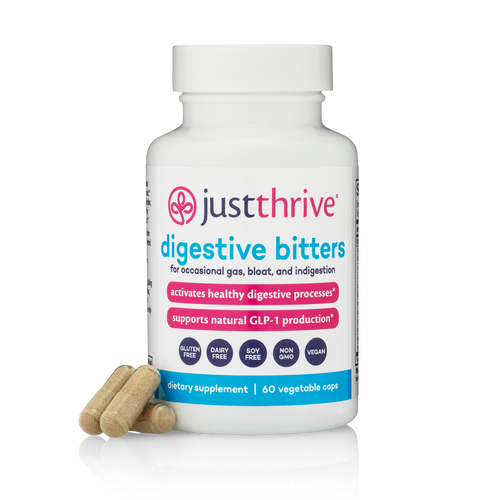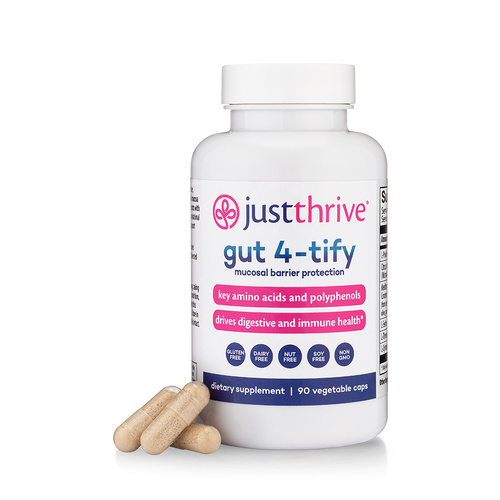How digestive issues can trigger sugar spikes
If you’ve been struggling to keep your blood sugar under control, you may be leaving out an important step.
Diet usually gets the blame for blood sugar spikes. But what you eat is not always the cause. Sometimes the problem goes beyond carbs.
Sometimes those sugar surges come from breakdowns in digestive function. That can lead to more spikes, slumps, and unpredictable blood glucose levels.
Getting digestion back on track can smooth out those highs and lows for steadier sugar responses.
Luckily, there’s a simple way to optimize your digestive function to keep your blood sugar right on track.
How Digestion Affects Blood Sugar
The digestive process breaks down food and releases glucose and other nutrients and compounds into your bloodstream. Your blood sugar levels depend on how fast that glucose gets released. And while that does depend partly on what you’ve eaten, the digestive process can affect the sugar release rate even more.
When your digestive system moves too fast, it speeds up glucose release leading to sugar spikes. Slowing down carbohydrate digestion helps keep blood sugar levels steadier.
When your digestive system moves too slowly, carbohydrates may not be fully broken down. That also causes erratic glucose release and potential sugar surges. Keeping digestion flowing at a good pace and fully breaking down foods helps level out blood glucose.

Enzymes and hormones also greatly impact digestion and blood sugar. They act as chemical messengers traveling through the system to stimulate digestive momentum, regulate appetite, and control blood sugar release. The ones most affecting blood sugar levels include:
- Amylase, the enzyme that converts carbohydrates into glucose that your body will use for energy
- Lipase to break down fats and protease to break down proteins so they can slow and counteract sugar release
- GLP-1 (glucagon-like peptide-1), which slows digestion, reduces appetite, signals insulin release, and regulates blood sugar balance [1,2,3]
- Ghrelin, the hunger hormone, increases blood sugar by stimulating glucagon (a hormone that tells the liver to send stored glucose into the bloodstream) and reducing insulin. High ghrelin levels lead to high blood sugar levels.[4]
- CCK (cholecystokinin) triggers bile and digestive enzymes to break down food. It also slows gastric emptying (food going from the stomach to the small intestine) which slows glucose delivery to the bloodstream.[5,6]
- GIP (glucose-dependent insulinotropic polypeptide) is a hormone that helps balance blood sugar by increasing insulin release.[7]
Stable blood sugar levels depend on every part of digestion working effectively. And you can help ensure that by taking some very simple steps.

Meal Sequencing Levels Out Glucose
Did you know that when you’re eating, the order in which you eat your food matters? You could eat the same exact meal that caused sugar spikes and sequence it differently to keep your blood sugar steady.
Meal sequencing plays a huge role in blood sugar management. So if you eat your food in a specific order, you can stop after-meal blood sugar levels from soaring. It’s that easy.
Research says eating your meals in this order levels out blood sugar:[8]
- fiber-rich vegetables
- fats and proteins
- carbohydrates and simple sugars
Practically speaking, here’s an example. Start with veggies, like a salad. Then eat some fats and proteins like avocado, olives, nuts, beef, chicken, salmon, and tofu. Save your carbs for last: anything from bread to fries to pasta to dessert. This meal sequence stabilizes blood sugar release, avoiding big spikes.
But eat the same meal backward, and the results are very different. If you go for the bread basket first, then some noodle soup, then a burger and fries, you’ll feel a sugar surge followed by a sugar slump.
One study found that people eating a meal in the correct sequence saw blood sugar 40.9% lower than people who ate “backward.”[9] The “correct sequence” group also had better insulin levels and felt full longer than the “backward” group.
And when you add meal sequencing to other proven strategies, it’s much easier to get and keep your blood sugar balanced and steady.
Digestive Priming Keeps Your System on Track
Your digestive system can work proactively or reactively… depending on how you support it. Digestive priming prepares the system in advance, giving it a natural heads up that food is coming. That gives enzymes and hormones a head start and promotes optimal digestive function.
Sometimes this happens with no effort at all, like when you smell a delicious aroma and your mouth starts to water. And you can make sure that priming action happens every time you eat.
The basics of digestive priming include:
- supporting your gut microbiome, the trillions of bacteria that live in your gut and promote complete digestion and nutrient absorption, as well as helping manage blood sugar
- stimulating enzyme and hormone release, which kicks off the whole digestive process
preparing your digestive tract to metabolize food completely
Luckily, nature provides just what you need to accomplish all of that for more efficient digestion and blood sugar balance.
Digestive Bitters Kickstart Your Natural Sugar Management System
Bitter flavor plays a key role in digestive priming. It lets your body know that something challenging is on the way, so it can prepare for incoming food.
Your body has bitter receptors—called T2R—throughout your entire body, not just on your tongue. When bitter compounds activate T2Rs, it sets off a chain reaction that turns on the enzymes and hormones required for complete digestion. That promotes insulin release and uptake, “Goldilocks” transit timing (not too fast, not too slow), and strong after-meal glucose control.[10,11,12]
Digestive bitters activate T2Rs that stimulate production and release of:
- GLP-1[13]
- GIP[14]
- CCK[15]
- Ghrelin[16]
Different bitters act on different parts of digestion.
- Bitter Melon, for example, helps regulate blood sugar and promotes insulin release and uptake.[17]
- Barberry encourages GLP-1 release, which helps manage blood sugar.[18]Dandelion root helps regulate sugar metabolism and balance blood sugar levels.[19]
- Sweet wormwood helps sensitize cells to insulin reception and balance blood sugar.[20]
- Hops flower extract stimulates CCK and GLP-1, both of which contribute to stable blood sugar levels after meals.[21,22]
Bitters help your digestive system work proactively, primed for breaking down foods before you take your first bite. This helps to optimize digestion and, in turn, keep healthy blood sugar levels steady.
Digestive Bitters Optimize Digestion to Keep Sugar Steady
You can take a proactive approach to smoother, more efficient digestion and healthy blood sugar balance. You can prime your digestive system with time-tested Digestive Bitters.
Just Thrive Digestive Bitters serves up all the balancing benefits of bitters in a unique capsule form. That means no harsh taste! Your T2R receptors will still get activated, stimulating all the hormones and enzymes that promote complete digestion. And you won’t have to endure intensely bitter flavor lingering on your tongue.
Digestive Bitters delivers a comprehensive holistic blend of 12 time-tested bitters including:
- Bitter melon
- Barberry
- Dandelion root
- Sweet wormwood
- Hops flower extract
And 7 additional traditional bitters that each contribute to digestive health
>> Stay steady and balanced after meals with Digestive Bitters every day.
And if you’re not sure about trying Digestive Bitters… we can help with that.
EVERY Just Thrive purchase is covered by our Bottom of the Bottle, 100% money back guarantee.
So you can try it to see if it works for you… and we feel confident that it will.
But if for any reason you don’t feel a difference, simply request a full product refund at any time. Doesn’t matter if it’s 3 months or even 3 years later. It doesn’t even matter if the bottle is empty! You’ll get your money back any time, no matter what. All you have to do is ask.
Sources
- Holst JJ. The physiology of glucagon-like peptide 1. Physiol Rev. 2007 Oct;87(4):1409-39.
- Bu T, Sun Z, Pan Y, Deng X, Yuan G. Glucagon-Like Peptide-1: New Regulator in Lipid Metabolism. Diabetes Metab J. 2024 May;48(3):354-372.
- Beiroa D, et al. GLP-1 agonism stimulates brown adipose tissue thermogenesis and browning through hypothalamic AMPK. Diabetes. 2014 Oct;63(10):3346-58.
- Mani BK, Shankar K, Zigman JM. Ghrelin's Relationship to Blood Glucose. Endocrinology. 2019 May 1;160(5):1247-1261. doi: 10.1210/en.2019-00074. PMID: 30874792; PMCID: PMC6482034.
- Cawthon CR, de La Serre CB. The critical role of CCK in the regulation of food intake and diet-induced obesity. Peptides. 2021 Apr;138:170492.
- Liddle RA, Rushakoff RJ, Morita ET, Beccaria L, Carter JD, Goldfine ID. Physiological role for cholecystokinin in reducing postprandial hyperglycemia in humans. J Clin Invest. 1988;81(6):1675-1681. doi:10.1172/JCI113505
- Kubota S, Liu Y, Iizuka K, Kuwata H, Seino Y, Yabe D. A Review of Recent Findings on Meal Sequence: An Attractive Dietary Approach to Prevention and Management of Type 2 Diabetes. Nutrients. 2020 Aug 19;12(9):2502.
- Shaheen A, et al. Postprandial Glucose and Insulin Response to Meal Sequence Among Healthy UAE Adults: A Randomized Controlled Crossover Trial. Diabetes Metab Syndr Obes. 2024 Nov 14;17:4257-4265.
- Palatini Jackson KM, Mhawish R, Komarnytsky S. Bitter Phytochemicals Acutely Lower Blood Glucose Levels by Inhibition of Glucose Absorption in the Gut. Endocrines. 2024; 5(3):304-322.
- Xie C, Wang X, Young RL, Horowitz M, Rayner CK, Wu T. Role of Intestinal Bitter Sensing in Enteroendocrine Hormone Secretion and Metabolic Control. Front Endocrinol (Lausanne). 2018 Sep 27;9:576.
- Rezaie P, Bitarafan V, Horowitz M, Feinle-Bisset C. Effects of Bitter Substances on GI Function, Energy Intake and Glycaemia-Do Preclinical Findings Translate to Outcomes in Humans? Nutrients. 2021; 13(4):1317.
- Kok BP, et al. Intestinal bitter taste receptor activation alters hormone secretion and imparts metabolic benefits. Mol Metab. 2018 Oct;16:76-87.
- Pelle MC, et al. Role of a Dual Glucose-Dependent Insulinotropic Peptide (GIP)/Glucagon-like Peptide-1 Receptor Agonist (Twincretin) in Glycemic Control: From Pathophysiology to Treatment. Life (Basel). 2021 Dec 25;12(1):29
- Chen MC, Wu SV, Reeve JR Jr, Rozengurt E. Bitter stimuli induce Ca2+ signaling and CCK release in enteroendocrine STC-1 cells: role of L-type voltage-sensitive Ca2+ channels. Am J Physiol Cell Physiol. 2006 Oct;291(4):C726-39.
- Janssen S, Laermans J, Verhulst PJ, Thijs T, Tack J, Depoortere I. Bitter taste receptors and α-gustducin regulate the secretion of ghrelin with functional effects on food intake and gastric emptying. Proc Natl Acad Sci U S A. 2011 Feb 1;108(5):2094-9.
- Basch E, Gabardi S, Ulbricht C. Bitter melon (Momordica charantia): a review of efficacy and safety. Am J Health Syst Pharm. 2003 Feb 15;60(4):356-9.
- Yu Y, Hao G, Zhang Q, Hua W, Wang M, Zhou W, Zong S, Huang M, Wen X. Berberine induces GLP-1 secretion through activation of bitter taste receptor pathways. Biochem Pharmacol. 2015 Sep 15;97(2):173-7
- Kania-Dobrowolska M, Baraniak J. Dandelion (Taraxacum officinale L.) as a Source of Biologically Active Compounds Supporting the Therapy of Co-Existing Diseases in Metabolic Syndrome. Foods. 2022 Sep 15;11(18):2858.
- Ghanbari M, Lamuki MS, Habibi E, Sadeghimahalli F. Artemisia annua L. Extracts Improved Insulin Resistance via Changing Adiponectin, Leptin and Resistin Production in HFD/STZ Diabetic Mice. J Pharmacopuncture. 2022 Jun 30;25(2):130-137.
- Barrea L, Annunziata G, Muscogiuri G, Arnone A, Tenore GC, Colao A, Savastano S. Could hop-derived bitter compounds improve glucose homeostasis by stimulating the secretion of GLP-1? Crit Rev Food Sci Nutr. 2019;59(3):528-535.
- Walker EG, et al. An extract of hops (Humulus lupulus L.) modulates gut peptide hormone secretion and reduces energy intake in healthy-weight men: a randomized, crossover clinical trial. Am J Clin Nutr. 2022 Mar 4;115(3):925-940.














